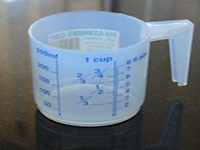 Whoever was the clever fellow or gal who thought up the idea of a measuring cup anyway? What happened if the user could neither read, nor subtract (much less add) and how did that affect their baking? No one may ever know the answer to the latter question, but the Babylonian civilization was the earliest on record to implement a unit for weight. (There were no diet organizations back then; only weight measures. Ah, modern civilization!) According to archaeological records, the Babylonian mina, which weighs about 23 ounces, is the earliest weight measurement known to man. Many ancient wall carvings depict cooks weighing according to this system. Through trading, these measuring standards spread from the Middle East to other countries and markets (black and other colors too). Eventually, they found their way to every diet center in the free world today.
Whoever was the clever fellow or gal who thought up the idea of a measuring cup anyway? What happened if the user could neither read, nor subtract (much less add) and how did that affect their baking? No one may ever know the answer to the latter question, but the Babylonian civilization was the earliest on record to implement a unit for weight. (There were no diet organizations back then; only weight measures. Ah, modern civilization!) According to archaeological records, the Babylonian mina, which weighs about 23 ounces, is the earliest weight measurement known to man. Many ancient wall carvings depict cooks weighing according to this system. Through trading, these measuring standards spread from the Middle East to other countries and markets (black and other colors too). Eventually, they found their way to every diet center in the free world today.
Other ancient cultures had measuring devices as well. To measure weight, the Chinese used the pitch of a pipe against a vessel, which was filled with something (opium perhaps?). The ancient Romans used the libra; a system of weight, which was later, adopted by medieval Europe and is the US equivalent of a pound.
The measuring cup is primarily a kitchen utensil, which is used to measure the volume of liquid or powder-form cooking ingredients such as juice, milk, water, flour, sugar, etc. It is also used for many other things in the average household as well. It can measure washing powder, liquid detergents or bleach. It is wise to use one measuring cup for food and another for everything else.
So the next time you take out your measuring cup, say hello and show some respect. Like you and I, it has a past. Unlike you or I, it never has to worry where its children are.
Happy measuring!

